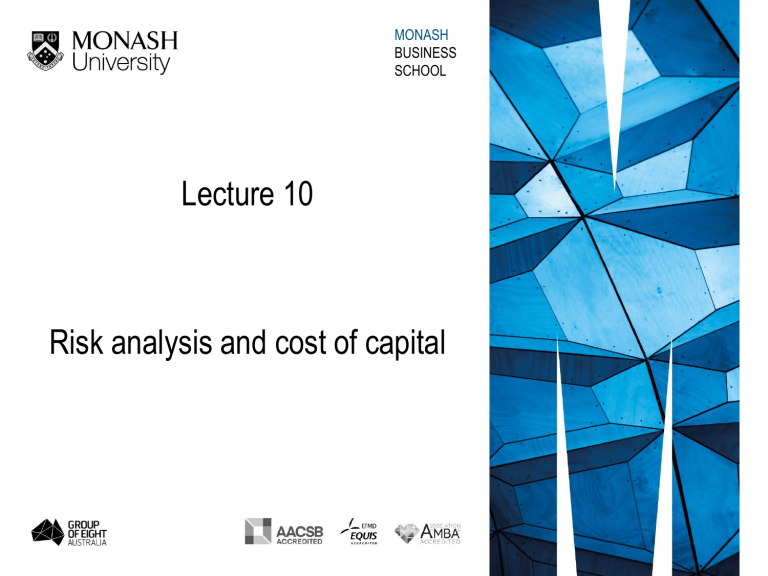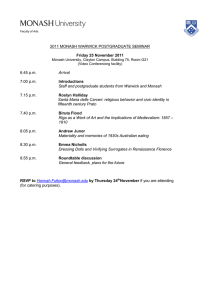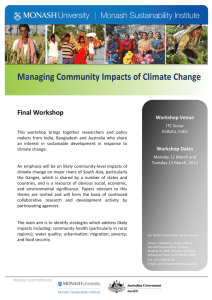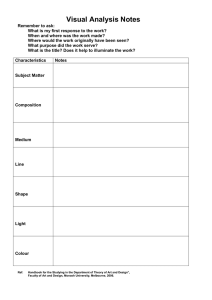
MONASH BUSINESS SCHOOL Lecture 10 Risk analysis and cost of capital Last week – Prospective analysis (Application - II) Assumptions on forecast financial items Basis for assumptions Forecasting financial line items Segment information and forecasting Sensitivity analysis (scenarios) Using forecast spreadsheet Case analysis – JB Hi-Fi. 2 MONASH BUSINESS SCHOOL 2 Valuation flow chart Capital market analysis •Stock liquidity •analysts’ coverage •information environment Business analysis •Macroeconomic and other external macro factor analysis •Industry analysis •Business strategy analysis Communication and governance analysis • • • • Management quality Disclosure quality Internal corporate governance External corporate governance Financial analysis Earnings quality and accounting analysis Prospective analysis (forecast) Risk analysis & discount rate Valuation MONASH BUSINESS 3 SCHOOL This week – Risk analysis and cost of capital • Types of risks • Measuring risks • Types of capital • Cost of equity • Weighted average cost of capital • Case analysis – JB Hi-Fi MONASH BUSINESS 4 SCHOOL Risk, cost of capital and valuation Source: http://people.stern.nyu.edu/adamodar/pdfiles/country/CostofCapitalCFA2015.pdf 5 MONASH BUSINESS SCHOOL MONASH BUSINESS SCHOOL Risk analysis Objectives of risks analysis • Risk Analysis is like understanding the application of a brake in the car • For managers risk analysis is not for slowing down but to help increase speed • For investors risk analysis helps understand the investment risks and identify opportunities MONASH BUSINESS 7 SCHOOL Crisis impact on sectors: 2009 vs 2020 Source: World Steel MONASH BUSINESS SCHOOL Total Government and Central Bank Stimulus Estimates in Response to Crisis (% of GDP) Source: Morgan Stanley 9 MONASH BUSINESS SCHOOL Risk chart Risk categories 1 2 3 4 Strategic Industry Market Alignment Decision making Operational Production Cost inefficiency Property Health and safety Management Image Control Reporting quality Project management Political War Instability Institutional Government policy change Financial Commodity price risk Liquidity Credit Foreign exchange Exogenous Earthquake Flood Volcanic Fire MONASH BUSINESS 10 SCHOOL Risk disclosure and risk mitigation • Risk related disclosure in annual reports • ASX Corporate Governance Council : Principles of Good Corporate Governance Principle 7: Companies should establish a sound system of risk oversight and management and internal control. • Recommendation 7.1: Companies should establish policies for the oversight and management of material business risks and disclose a summary of those policies • Recommendation 7.2: The board should require management to design and implement the risk management and internal control system to manage the company’s material business risks and report to it on whether those risks are being managed effectively. The board should disclose that management has reported to it as to the effectiveness of the company’s management of its material business risks. • Recommendation 7.3: The board should disclose whether it has received assurance from the chief executive officer (or equivalent) and the chief financial officer (or equivalent) that the declaration provided in accordance with section 295A of the Corporations Act is founded on a sound system of risk management and internal control and that the system is operating effectively in all material respects in relation to financial reporting risks. Presentation title MONASH BUSINESS 1 28th February 2011 SCHOOL 1 SOX Risk Disclosure -20F filing of BHP External risks • Fluctuations in commodity prices and impacts of ongoing global economic volatility may negatively affect our results, including cash flows and asset values • Our financial results may be negatively affected by currency exchange rate fluctuations • Reduction in Chinese demand may negatively impact our results • Actions by governments or political events in the countries in which we operate could have a negative impact on our business Business risks • Failure to discover new reserves, maintain or enhance existing reserves or develop new operations could negatively affect our future results and financial condition • Potential changes to our portfolio of assets through acquisitions and divestments may have a material adverse effect on our future results and financial condition • Increased costs and schedule delays may adversely affect our development projects MONASH BUSINESS 12 SCHOOL SOX Risk Disclosure -20F filing of BHP (cont.1) Financial risks • If our liquidity and cash flow deteriorate significantly it could adversely affect our ability to fund our major capital programs • We may not recover our investments in mining, oil and gas assets, which may require financial write-downs • The commercial counterparties we transact with may not meet their obligations which may negatively impact our results Operational risks • Cost pressures and reduced productivity could negatively impact our operating margins and expansion plans • Unexpected natural and operational catastrophes may adversely impact our operations • Our non-controlled assets may not comply with our standards • Breaches in our information technology security processes may adversely impact the conduct of our business activities MONASH BUSINESS 13 SCHOOL United Nations Sustainable Development Goals Page 14 Confidential MONASH BUSINESS SCHOOL Why should management bother about UNSDG? • The world is watching and take keen interest in recent developments • Broader stakeholder groups question the approach of large companies more than ever before • Information on the actions of an organization is now publicly available • There are significant economic benefits of engaging with UNSDG • Evidence of economic benefits of adopting and delivering on UNSDGs for an organization 20/07/2022 Confidential MONASH BUSINESS SCHOOL What do investors know about large companies? • Business Ethics • Health and Safety • Climate Change • Land Use & Biodiversity • Controversial Investments • Product Safety • Customer Relations • Substantial Emissions • Employee Relations • Supply Chain • Environment Concerns • Union Relations • Governance Structures • Water Management Page 16 20/07/2022 Confidential MONASH BUSINESS SCHOOL ESG score statistics – sample companies Measures Mean Lower Quartile Median Upper Quartile Minimum Maximum Overall Score 0.7903 0.7365 0.8981 0.9465 0.0323 0.9868 Economic Score 0.6876 0.5309 0.7826 0.9138 0.0201 0.9877 Environmental Score 0.7919 0.8171 0.9255 0.9435 0.0846 0.9732 Corporate Governance Score 0.7162 0.6362 0.7808 0.9051 0.0556 0.9841 Social Score 0.7312 0.6363 0.8317 0.9243 0.0430 0.9917 Page 17 20/07/2022 Confidential MONASH BUSINESS SCHOOL Sustainability disclosures – impact of PS2 and COVID-19 6,00 Sustainability dislosure index (mean values) 5,50 5,00 4,50 4,00 3,50 3,00 2011 2012 2013 SUSTAIN_INDEX 2014 2015 SUSTAIN_PRACTICE 2016 2017 2018 SUSTAIN_REPORT 2019 2020 2021 CLIMATE_RISK MONASH BUSINESS SCHOOL Pre COVID-19 and COVID-19 pandemic period Two-sample t-test of firms in the pre COVID-19 and COVID-19 pandemic period COVID-19 =0 COVID-19 = 1 N = 8,809 N = 985 Diff. in mean t-statistics Variables TOBIN’SQ 2.542 2.483 0.059 0.10 ROA -0.411 -0.233 -0.178 -1.90* SUSTAIN_INDEX 5.097 5.710 -0.613 -6.27*** SUSTAIN_PRACTICE 5.140 5.751 -0.611 -6.29*** SUSTAIN_REPORT 4.378 4.822 -0.444 -9.36*** GUNNFOG_RANK 4.724 4.780 -0.056 -0.60 MONASH BUSINESS SCHOOL Research questions RQ1: Is there any significant association between a firm’s sustainability practices and its valuation (accounting performance) in the year of the COVID-19 pandemic? RQ2: Does the association between a firm’s sustainability practices and its valuation (accounting performance) vary across COVID-19 pandemic years and non-pandemic years? MONASH BUSINESS SCHOOL Results of regression estimates for test of company performance Test of RQ1 using market measure TOBINS’ Q as dependent variable 2011 to 2021 (all years) Intercept SUSTAIN_INDEX SUSTAIN_PRACTIC E SUSTAIN_REPORT 2011 to 2019 (pre COVID-19 years) 2020 and 2021 (COVID-19 years) (1) (2) (3) (4) (5) (6) (7) (8) (9) 3.777* 3.618* 1.964 2.947 2.745 1.524 5.674** 5.604** 4.100 (1.77) (1.69) (0.87) (1.47) (1.37) (0.71) (2.03) (2.00) (1.44) 0.466** * (4.85) 0.471*** 0.251* (4.46) (1.74) 0.523*** 0.531*** 0.283* (5.37) (4.96) (1.93) 0.773*** 0.733*** 0.709*** (3.89) (3.19) (3.08) MONASH BUSINESS SCHOOL Results of regression estimates for test of company performance Test of RQ1 using accounting measure ROA as dependent variable 2011 to 2021 (all years) (1) Intercept SUSTAIN_INDEX SUSTAIN_PRACTIC E SUSTAIN_REPORT 2011 to 2019 (pre COVID-19 years) 2020 and 2021 (COVID-19 years) (2) (3) (4) (5) (6) (7) (8) (9) 0.978*** (-4.00) (-3.94) -0.520** -1.108*** -1.088*** -0.665*** -0.094 -0.094 0.011 (-1.99) (-4.74) (-4.65) (-2.66) (-0.42) (-0.42) (0.05) -0.992*** -0.073*** -0.076*** -0.016 (-6.50) (-6.20) (-1.35) 0.077*** (-6.77) -0.081*** -0.015 (-6.48) (-1.27) -0.172*** -0.180*** -0.046** (-7.45) (-6.75) (-2.52) MONASH BUSINESS SCHOOL Results of regression estimates for firm performance using climate risk disclosure Panel A: Test of RQ1 Intercept CLIMATE_RISK TOBIN’SQ ROA 1.945 (0.86) 0.673*** (3.79) -0.639** (-2.43) -0.121*** (-5.86) TOBIN’SQ ROA 1.440 (0.74) 0.655*** (3.66) 0.465 (0.30) 0.031 (0.81) Yes Yes Yes 9,794 0.113 -0.805*** (-3.55) -0.118*** (-5.66) 0.173 (0.95) -0.006 (-1.30) Yes Yes Yes 9,794 0.109 Panel B: Test of RQ2 Intercept CLIMATE_RISK COVID-19YEAR CLIMATE_RISK*COVID-19YEAR Control variables Industry fixed effect Year fixed effect N Adjusted R2 MONASH BUSINESS SCHOOL Important considerations for investors and analysts Climate change risks • Does the company face risks associated with climate change? Explain • What is the company doing about climate change-induced risks? • What is your assessment of the company’s strategy to address climate change risk? COVID-19 risks • Does the company face risks associated with the spread of COVID-19? Explain • What is the company doing about COVID-19 induced risks? • What is your assessment of the company’s strategy to address COVID-19 risk? Ukraine-Russia conflict risks • Does the company faces risks due to the conflict between Ukraine and Russia? Explain • What is the company doing about the potential risks due to the conflict? • What is your assessment of the company’s strategy to address the risk? MONASH BUSINESS 24 SCHOOL MONASH BUSINESS SCHOOL Cost of capital overview Short exercise Assume that there are two companies operating in the same country and each earn $100 in free cash flows in the current year. Both companies have the same projected growth rate of 5 percent annually in perpetuity. Analysis shows that the first company has a current value of $5,000 and the second company has a current value of $2,000. Also assume that the capital structures of the two companies is the same and remain constant. What do you think drives this difference in 26 value? MONASH BUSINESS SCHOOL Systematic and unsystematic risk • Systematic risk – systematic or unavoidable risk is risk arising from factors which affect the whole market such as wars, financial crisis, national economic changes etc. • Unsystematic risk – is avoidable risk unique to each separate investment such as effect of strikes, emergence of new competitor, change in management etc. MONASH BUSINESS SCHOOL Cost of capital Cost of Capital Valuation Corporate Finance • Investment Analysis • Capital Structure • Dividend Policy Hurdle Rate – invest if return on investment is at least as much as the cost of capital of the investment Optimising tool – choose the capital structure that minimises the cost of capital Used to determine whether the company should retain cash or return it to investors 28 MONASH BUSINESS SCHOOL How stocks compare with government bonds Hist o r ic al S t o ck Ret u r n s an d 10-y ear Go v en men t Bo n d Yield s 20 15 10 Dec-2018 Oct-2018 Aug-2018 Jun-2018 Apr-2018 Feb-2018 Dec-2017 Oct-2017 Aug-2017 Jun-2017 Apr-2017 Feb-2017 Dec-2016 Oct-2016 Aug-2016 Jun-2016 Apr-2016 Feb-2016 Dec-2015 Oct-2015 Aug-2015 Jun-2015 Apr-2015 -5 Feb-2015 0 Dec-2014 RETURN 5 -10 -15 -20 AGB 10 Year ^AORD Data Source: Reserve Bank of Australia and Yahoo! Finance 29 MONASH BUSINESS SCHOOL Cost of capital and valuation The cost of capital is the discount rate used in valuation – Note that for the purpose of valuation, the cost of capital is the opportunity cost of investing in something of equivalent risk It must meet the following criteria: – Include the opportunity cost of all investors – Must weight the security’s required return by the target market-based weight and not historical cost – Any financing related benefits must be included – Must be computed after tax – Must be based on the same expectations of inflation as those in calculating the free cash flow – Duration of securities used should match the duration of cash flows 30 MONASH BUSINESS SCHOOL MONASH BUSINESS SCHOOL Weighted average cost of capital (WACC) Weighted average cost of capital (WACC) A simple expression for WACC: D E WACC rd (1 t ) re V V Where, – D/V: Target debt to enterprise value based on market values – E/V: Target equity to enterprise value based on market values – rd: The cost of debt – re: The cost of equity – t: The marginal tax rate 32 MONASH BUSINESS SCHOOL MONASH BUSINESS SCHOOL Cost of equity: CAPM How good is CAPM for estimating cost of equity? • CAPM just works okay (does not work if not in a CAPM regime). • Lacks perfection • Simply a calculation based on risk and reward • Has short comings though widely used • Useful during CAPM regimes otherwise not (refer to ASX AllOrd historical data) • Way out is to use historical equity risk premium instead of current market return MONASH BUSINESS SCHOOL Use of CAPM- KPMG Valuation Practices Survey Presentation title MONASH BUSINESS 3 SCHOOL 5 Cost of equity: CAPM (capital asset pricing model) 𝑟𝐸 = 𝑟𝑓 + 𝛽(𝑟𝑚 − 𝑟𝑓 ) Risk-free rate beta Equity risk premium • Based on CAPM • CAPM has been questioned but – It still works for long-term (yearly) returns – It is intuitive – Easier to implement than alternate models 36 MONASH BUSINESS SCHOOL MONASH BUSINESS SCHOOL Risk free rate Risk-free rate Rate on long-term govt. bonds – Should ideally match duration with that of firm’s cash flows Commonly used government bond 2.75% (currently) Real or nominal? – Nominal if inflation is built into the cash flows -- consistency Current or historical average? If govt. bonds have default risk, then subtract the default risk premium – Example: The current 10-year government of India bonds have a YTM of 7.56%. These bonds were rated BAA2 by Moody’s (translating into a default spread of 2.15%). Then the true risk-free rate is 5.41%. – The 10-year Australian Government Bonds have a AAA credit rating, which means that the default spread is 0. 38 MONASH BUSINESS SCHOOL Impact or coronavirus: Stock versus bonds Source: The Motley Fool MONASH BUSINESS SCHOOL MONASH BUSINESS SCHOOL Beta Beta • Beta is a risk measure comparing the volatility of a stock's price movement to the general market. • Beta provides a good idea of a stock's inherent risk or sensitivity to general market fluctuations. • High beta stocks react strongly to variations in the market, and low beta stocks are less affected by market variations. 41 MONASH BUSINESS SCHOOL Beta estimation Daily, weekly, or monthly returns? – Daily returns yield more observations, but betas based on daily returns could be biased towards zero because of non-synchronous trading – Monthly returns yield few observations and therefore high standard errors of estimates – Weekly returns may be a good compromise, although even weekly data has nonsynchronous trading for many securities Market index? – Theoretically, returns on all possible assets including real estate and human capital – In practice, a readily available index such as S&P500, AORD, ASX200 – Usually local market index, because most investors do not diversify across countries – Does not make much difference 42 MONASH BUSINESS SCHOOL Beta estimation time periods Is historical beta appropriate to use? – Theoretically no – Adjust, if you know that the firm is getting into another industry How long back to go? – No more than 5 years – Monthly for 5 years, monthly for 1 year Graph rolling betas to detect systematic changes in the stock’s risk Use a reasonably long time-series to measure beta 43 MONASH BUSINESS SCHOOL Predicted beta – Disney and Netflix 44 MONASH BUSINESS SCHOOL MONASH BUSINESS SCHOOL Equity risk premium (ERP) Equity Risk Premium (ERP) • ERP is forward-looking expectation of stocks less 10-year government bonds • ERP in Australia since 1958 and till 2005 was 6.3% calculated as an geometric mean • World average till 2001 was 5.9% • During GFC and COVID-19 pandemic ERP increased slightly • The Australian market has a larger representation of resourcebased companies, which have high levels of systematic risk. • An incomplete list of factors that would support a higher MRP in Australia include being a smaller market, with less liquidity, smaller companies, less diversity and fewer risk management opportunities. MONASH BUSINESS SCHOOL Equity risk premium comparison Source: http://pages.stern.nyu.edu/~adamodar/New_Home_Page/datafile/ctryprem.html 47 MONASH BUSINESS SCHOOL Implied Market Risk Premia: Australia 48 MONASH BUSINESS SCHOOL Historic equity risk premium Source: KPMG Corporate Finance (Australia) MONASH BUSINESS SCHOOL Implied cost of equity Not very useful for valuation – Guess why? Why use it then? – Three reasons: Can be used as a benchmark to test the “margin of error” – For instance, suppose CAPM produces an estimate of 10% and using this rate, you determine that the stock is under-valued. However, if the implied cost of equity is 10.2%, you may not want to invest in the stock. If the implied cost of equity is 15%, it may be a different story Can be used to calculate an implied cost of equity for an entire sector Can use this approach to calculate an implied cost of equity for a company in different time periods and then compute an average cost of equity from those estimates 50 MONASH BUSINESS SCHOOL MONASH BUSINESS SCHOOL Cost of Debt The cost of debt For investment-grade debt, the cost of debt can be reasonably approximated to the yield to maturity (YTM) Theoretically, pd rc rc rc FV ... (1 YTM ) (1 YTM ) 2 (1 YTM )T (1 YTM )T T (1 YTM ) n 1 rc n FV (1 YTM )T 52 MONASH BUSINESS SCHOOL On the yield to maturity (YTM) The YTM should be calculated on liquid, option-free, long-term debt For US companies, the YTM can be obtained free of charge from TRACE (data available from 2002) For Australian companies, the ASX website provides the information for publicly traded debt 53 MONASH BUSINESS SCHOOL What if the company’s debt is not publicly traded? Two approaches: – Look at the most recent borrowing history Cost of debt is the average cost of borrowing – Calculate the synthetic spread Calculate the interest coverage ratio of the company and compare with those of companies that have publicly rated bonds Apply the average spread of companies with same interest coverage ratio 54 MONASH BUSINESS SCHOOL Next week (Lecture 11) • Lecture – Valuation (theory and application – I) • Aims and objectives of valuation • Myths (truth) about valuation • Valuation methods • Terminal value calculation • Case analysis – JB Hi-Fi • Tutorial – Discussion of lecture content of week 10 Risk analysis and cost of capital – Discussion on assessment requirements – Assignment 2 (Section G) – Applying risk analysis and calculating cost of equity capital of JB Hi-Fi – Discussion of exam questions from the past MONASH BUSINESS 5 SCHOOL 5



